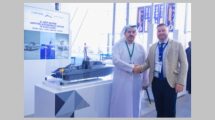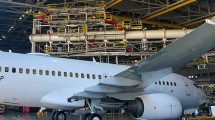 Communications on the move (COTM) is used across a variety of vehicles to provide continuous and seamless satellite connectivity, while the vehicle is in motion. It can be used in a variety of different vehicles, including ships, aeroplanes and land vehicles like trucks and trains. The basic principle is that the vessel is equipped with a satellite antenna and is able to establish communication with the satellite of choice, and in accordance with the frequency plan, to maintain that communication while in-motion.
Communications on the move (COTM) is used across a variety of vehicles to provide continuous and seamless satellite connectivity, while the vehicle is in motion. It can be used in a variety of different vehicles, including ships, aeroplanes and land vehicles like trucks and trains. The basic principle is that the vessel is equipped with a satellite antenna and is able to establish communication with the satellite of choice, and in accordance with the frequency plan, to maintain that communication while in-motion.
According to Darin Anderson, Director, International Business Development at ThinKom Solutions: “In-motion can mean a variety of things from a vessel being stationary on the water but the antenna system needing to accommodate for the pitch, roll and yaw of the vessel, to an aircraft flying at around 500+ knots an hour, to a rail or high-speed rail (HSR) application in slightly slower speeds or to a military surveillance or broadcast vehicle that is in improvised or bad road environments.
“There are a number of key elements for SOTM antenna systems to work efficiently, they must have the capability to find, lock and track these satellites, that are approximately 35,000 kilometres from the earth, and they must maintaining the minimum pointing accuracies established by the various regulatory authorities governing the satellite manufacturers, namely the ITU, FCC, etc. There is a unique coordinated effort between primarily three areas of focus; satellite and teleport operator, modem manufacturer, and antenna solution provider. All three areas need to be in sync on many variables to ensure successful and reliable operations for COTM use,” explains Anderson.
A lot has changed in the field of terminals and antennae too. There is always a need for them to be smaller and lighter, yet at the same time more powerful and able to access different satellite bands, as well as being future-proof.
Henrik Nørrelykke, VP Land Mobile Business, Cobham SATCOM says: “In general terminal aperture sizes are coming down as a consequence of the deployment of more powerful satellites and the rapid deployment of Ka-band satellites, both of which allow for increased throughputs on smaller aperture sizes.”
High Throughput Satellites for Ka and Ku-band are here today, with more satellites coming up quickly into global markets. Anderson thinks these satellite solutions will afford the various markets many enhanced capabilities for man-pack and SOTM solutions that are smaller and lighter in antenna design yet able to achieve the same or greater bandwidth speeds with possibly more saving on the bandwidth costs to meet the increasing demands of use.
The aviation industry is becoming more active than ever for on-board satellite connectivity, with the ability to make calls from your mobile phone and browse the internet on your tablet, whilst 35,000 feet in the air.
Anderson says: “The insatiable demand for reliable, high speed connectivity anywhere and anytime does not stop once one boards a plane whether a private jet to a large commercial airliner. The demand remains constant and airlines around the world are lining up their satcom technology partners.
“ThinKom is positioned extremely well in this space for longevity. Connectivity is not new to aviation, but what is new is the 5 to 10x speeds with great bit per Hz capability that ThinKom is providing to the commercial Ku air transport space, with our partner GoGo, to their airline customers.
“As Ka capacity continues to grow and will be reaching global coverage offerings, Ka aero demand is just as strong and ThinKom offers the same features benefits in Ka (military and commercial) frequency bands as well,” continues Anderson.
Beyond aeronautical connectivity, the maritime sector has been a huge customer of COTM. In due time, niche markets within the maritime sector will emerge for more military or even the luxury super yacht industry, simply for the appeal to move away from traditional tall domed antenna systems to more discreet or non-visible antenna systems, as long as performance is not compromised.
Nørrelykke says: “The maritime sector has all along been the driver for COTM deployments and continues to be the largest and by far the most well developed COTM market (all maritime satellite terminals are by nature COTM terminals). Cobham SATCOM has a very long history of maritime COTM deployments and works with Inmarsat FleetBroadband terminals (the maritime services based on the BGAN network) and is a player in maritime VSAT across all bands.”
Nørrelykke also adds that the military has historically been the absolute largest user of land based COTM systems. The situation is expected to gradually swing in favour of the various commercial markets – a transition which is expected to last for a long period.
Anderson agrees and says that the military has the most use for COTM applications, because it not just covers one mode of transportation, but rather several; such as trucks, tanks, fighter jets, navy vessels and others.
“From the fighter jets to the drones, large aircraft carrier or small light quick response vessels, to the ground troops forward operations and tactical vehicles to intelligence gathering covert operations; COTM solutions continue to grow and are a necessity within the military environment providing enhanced capability or redundancy. Hybrid networks too mesh together with other terrestrial communications networks,” he says.
Anderson goes on to say that the environments when there is neither terrestrial infrastructure available, or there are security concerns for one reason or another, COTM provides untethered freedom to go to locations far and wide and yet not risk being disconnected. This is particularly true for vehicles in the Middle East that are equipped to go into the desert on luxury camping trips, for rich clientele, that cannot afford to ever lose connectivity.
“For some cases it may be as simple as maintaining a GSM backhaul with a BTS or Picocell in the vehicle trunking back to a primary telco teleport over satellite for the many other applications that can be applied once a satellite backhaul or reach back link is in place. There is no loss in the connected capability that is common and in high demand in our everyday personal and business life,” adds Anderson.
With technology and capability keenly addressing R&D government development work, the gap is shortening considerably on Ku and Ka-band HTS demands for small form and fit terminal solutions that ThinKom is bringing to the global markets.
Thinkom is bullish about the future of COTM, due to its optimised efficiencies of flat and ultra-thin core technology, namely ThinKom’s CTS and VICTS solutions in a variety of frequency bands. Anderson says the company is making a very significant impact into a number of growing markets.
According to Northern Sky Research, the COTM market is projected to grow 12.6% per annum, on average until 2022. Nørrelykke thinks the largest monetary growth is expected to come from L-band, while the largest relative growth is expected to come from HTS systems, which is growing from a very modest base.
“A significant element of the L-band growth is expected to come from low speed and low cost Mobile M2M solutions, which are predicted to have very significant growth rates following on from the current aggressive growth of the M2M sector in general,” concludes Nørrelykke.












Add Comment